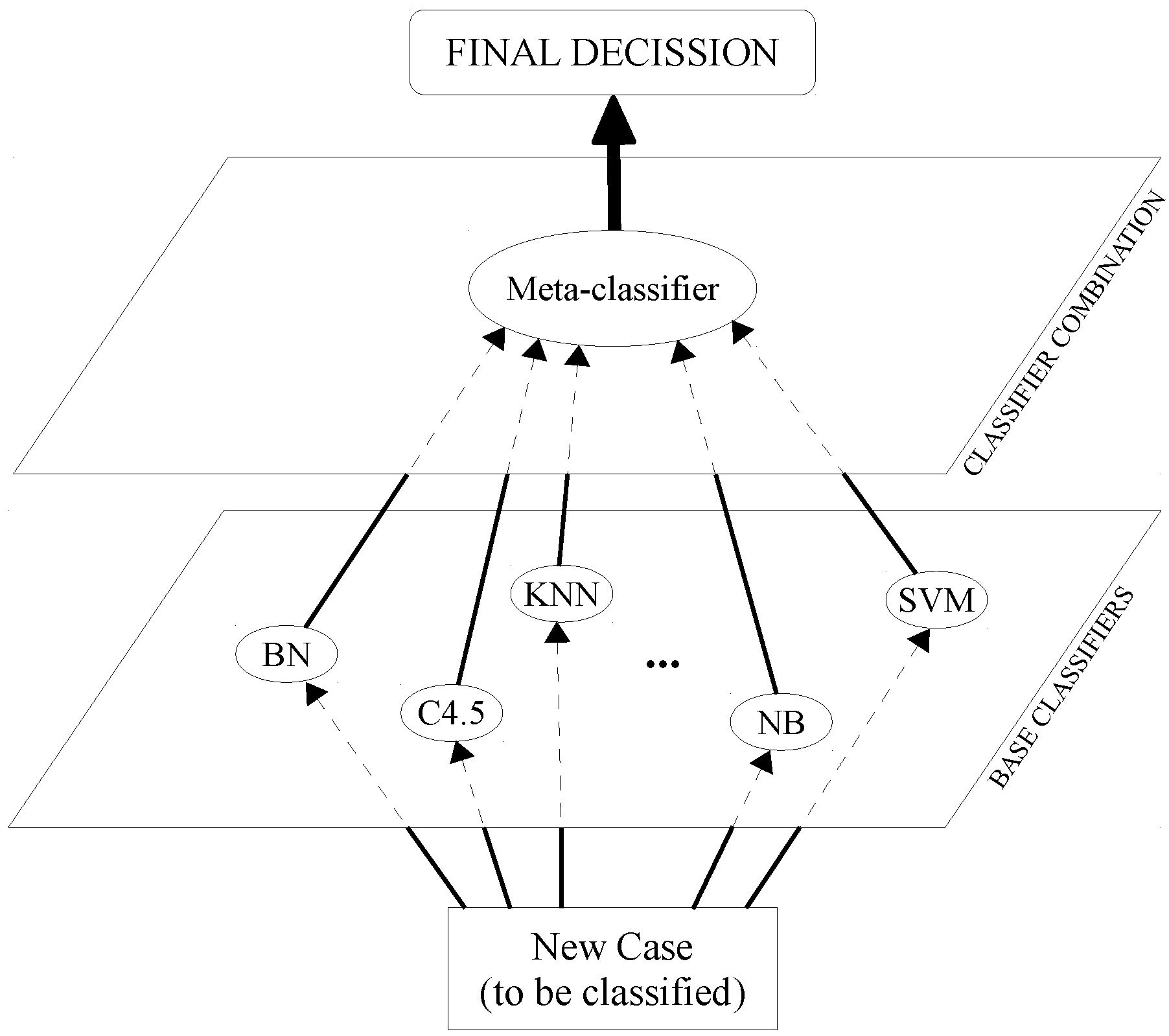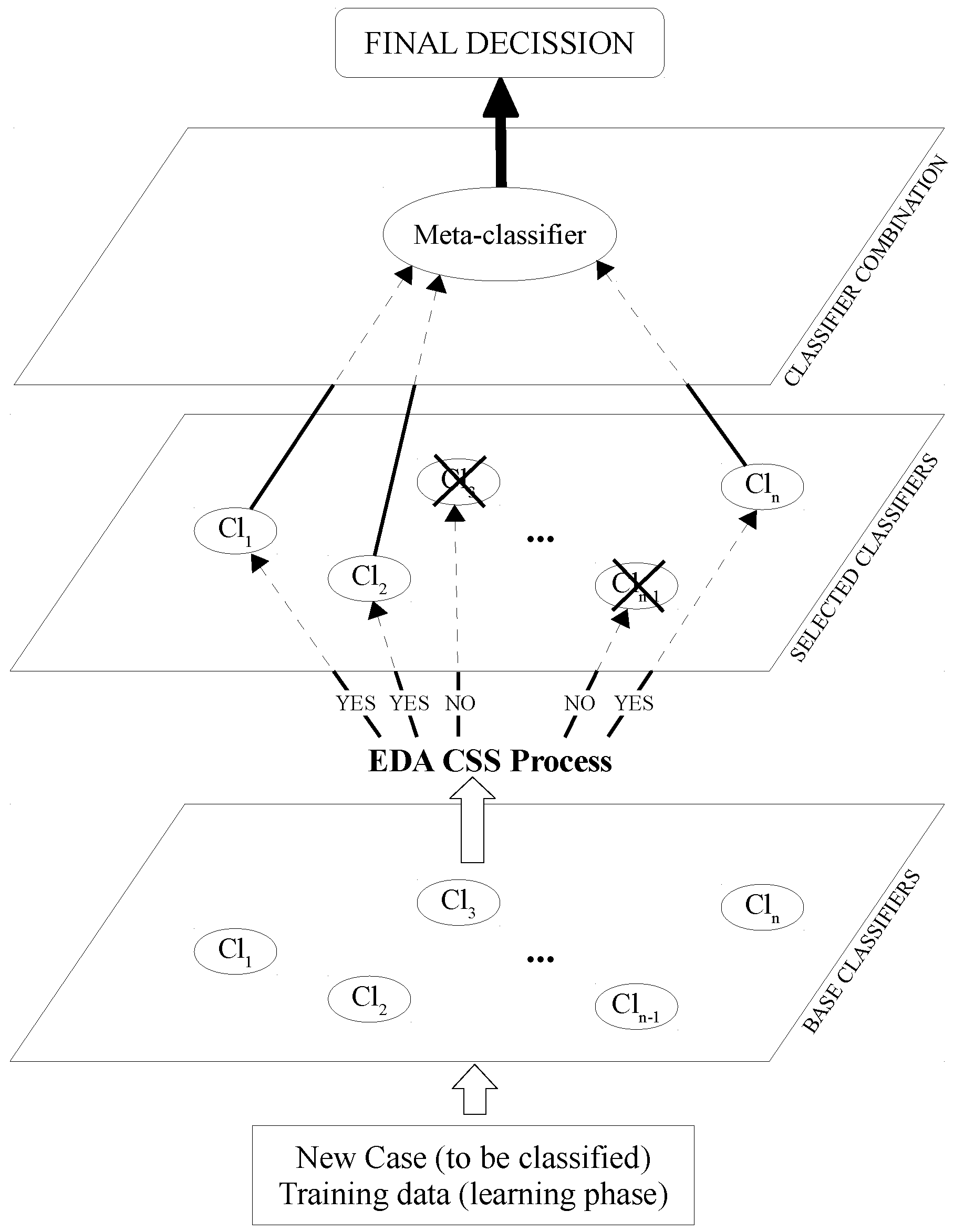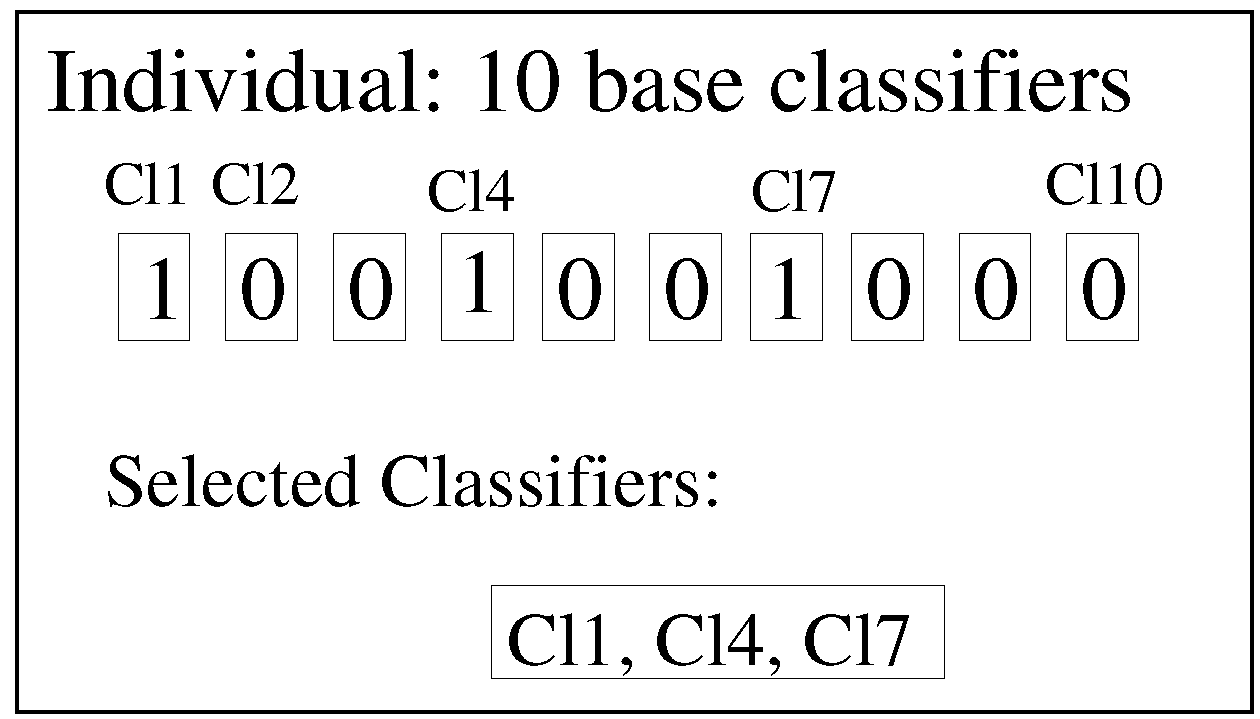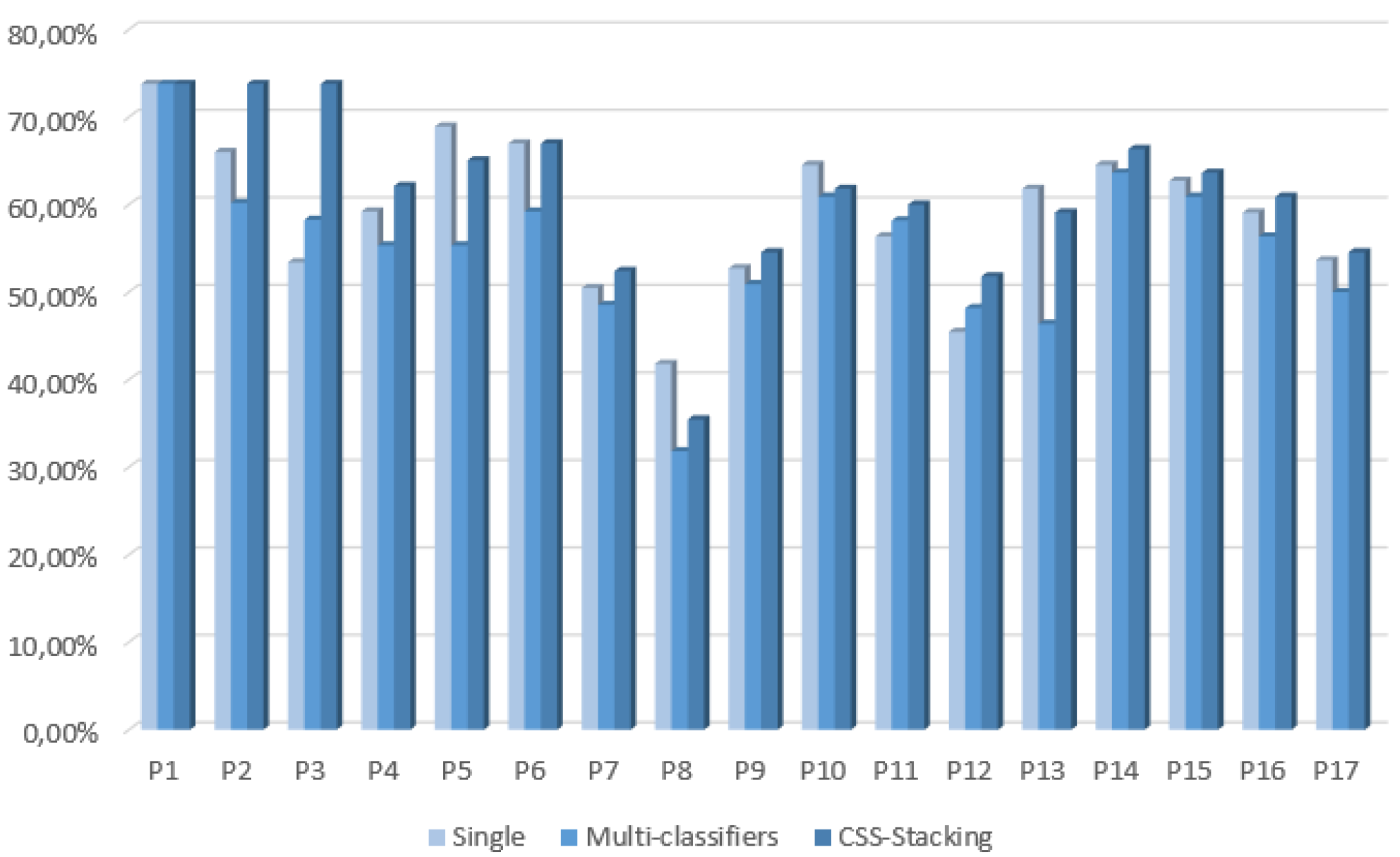1. Introduction
Affective computing is an emerging area that tries to make human-computer interaction (HCI) more natural to humans. This area covers topics, such as affect or emotion recognition, understanding and synthesis. Computing systems can better adapt to human behavior taking non-verbal information into account. As Mehrabian suggested [
1], verbal information comprises around 10% of the information transmitted between humans, while around 90% is non-verbal. This is why the inclusion of emotion-related knowledge in HCI applications improves the interaction by increasing the level of understanding and decreasing the ambiguity of the messages.
The expression of emotions by humans is multimodal [
2]. Apart from verbal information (written or spoken text), emotions are expressed through speech [
3,
4,
5], facial expressions [
6], gestures [
7] and other nonverbal clues (mainly psycho-physiological). With regard to the speech communication modality, the literature shows that several parameters (e.g., volume, pitch and speed) are appropriate to generate or recognize emotions [
8]. This knowledge is important either to emulate diverse moods reflecting the user’s affective states or, in the case of a recognizer, to create patterns for classifying the emotions transmitted by the user.
Affective speech analysis refers to the analysis of spoken behavior as a marker of emotion, with a focus on the nonverbal aspects of speech [
9]. Speech emotion recognition is particularly useful for applications that require natural human-machine interaction, in which the response to the user may depend on the detected emotion. Furthermore, it has been demonstrated that emotion recognition through speech can also be helpful in a wide range of other several scenarios, such as e-learning, in-card board safety systems, medical diagnostic tools, call centers for frustration detection, robotics, mobile communication or psychotherapy, among others.
Nevertheless, recognizing emotions from a human’s voice is a challenging task due to multiple issues. First, it must be considered that emotions’ expression is highly speaker, culture and language dependent. In addition, one spoken utterance can include more than one emotion, either as a combination of different underlying emotions in the same portion or as an individual expression of each emotion in different speech segments. Another interesting aspect is that there is no definitive consensus among the research community regarding which are the most useful speech features for emotion recognition. One possible cause may be the high impact of the variability introduced by the different speakers in commonly-used prosodic features. Finally, selecting the set of emotions to classify is an important decision, which can affect the performance of the speech emotion recognizer. Many works on the topic agree that any emotion is a combination of primary emotions. The primary six emotions include anger, disgust, fear, joy, sadness and surprise [
10].
In this paper, we present a study on emotion recognition based on two different sets of speech features extracted from emotional audio signals recorded by professional actors. The analysis was performed on two datasets called RekEmozioand the Berlin Emotional Speech (Emo-DB) database. RekEmozio contains bilingual utterances in Basque and Spanish languages [
11], whilst Emo-DB [
12] includes sentences recorded in German. Both databases were designed to cover the six primary emotions plus the neutral one, and each recording contained one acted emotion. The classification approach was focused on the categorical recognition of the seven emotions included in the open Emo-DB and the RekEmozio dataset, which is currently in the process of becoming publicly available to the community.
The experiments were divided into three main phases. The first phase corresponded to the construction and evaluation of 10 base supervised classifiers, multi-classifier systems (bagging, boosting and standard stacking generalization) and bi-level multi-classifiers based on the classifier subset selection for stacked generalization (CSS stacking) method on the RekEmozio dataset. For this end, local and global speech parameters containing prosodic, quality and spectral information were computed from each recording through in-house feature extraction algorithms. The selected supervised classifiers for this phase were the following: Bayesian Network (BN), C4.5, k-Nearest Neighbors (kNN), KStar, Naive Bayes Tree (NBT), Naive Bayes (NB), One Rule (OneR), Repeated Incremental Pruning to Produce Error Reduction (RIPPER), Random Forest (RandomF) and Support Vector Machines (SVM). These classifiers were also used to build the CSS stacking classifiers in this first phase.
The aim of the second phase was to verify the efficiency of the CSS stacking classification paradigm on the RekEmozio dataset using: (1) a well-known set of acoustic parameters (extended version of the Geneva Minimalistic Acoustic Parameter Set (eGeMAPS)); and (2) different base classifiers in the first layer. For this purpose, CSS stacking classifiers were built using the best meta-classifier of the first phase. In the second phase, we applied the following base classifiers in the first layer: MultiLayer Perceptron (MLP), Radial Basis Function network (RBF), Logistic Regression (LR), C4.5, kNN, NB, OneR, RIPPER, RandomF and SVM. Hence, the MLP, RBF and LR classifiers were added with respect to the first phase, and the BN, KStar and NBT were discarded.
The third phase consisted of testing the CSS stacking paradigm over the well-known and open Emo-DB. To this end, the same standard classifiers and acoustic features (eGeMAPS) of the second phase were used to build single, standard stacking and CSS stacking classifiers. We decided to leave out the bagging and boosting classifiers because of their poor performance in the first phase.
The paper presents the results from three phases. Regarding the first phase, the results obtained when applying each classification method to each actor were presented, providing a comparison and discussion between each of the several classification paradigms proposed. Concerning the second phase, the results obtained with the CSS stacking classifier are given for each actor, and a comparison with the CSS stacking classifiers from the first phase is also provided. Finally, in the third phase, only the three classifiers with a better score have been presented for each of the constructed systems (single, standard stacking and CSS stacking). The performances of these classifier systems have been compared to each other and to other results obtained in related works in the literature over the same Emo-DB.
In addition, this paper aims to serve as a forum to announce that the RekEmozio dataset will be publicly available soon for research purposes. The aim is to provide the scientific community a new resource to make experiments in the speech emotion recognition field over audio and video acted recordings, several made by actors, others by amateurs, in the Spanish and Basque languages.
The rest of the paper is structured as follows.
Section 2 introduces related work.
Section 3 details the RekEmozio and Emo-DB datasets, in addition to the two sets of speech features used in this work. In
Section 4, how EDA was applied for the stacking classification method is explained.
Section 5 describes how the experiments that have been carried out were performed, specifying which techniques have been used in each step of the process.
Section 6 explains the obtained results and provides a discussion.
Section 7 concludes the paper and presents future work.
2. Related Work
Many studies in psychology have examined vocal expressions of emotions. Eyben
et al. [
8], Schuller
et al. [
3,
9], Scherer [
4] and Scherer
et al. [
5] provide reviews of these works. Besides, during recent years, the field of emotional content analysis of speech signals has been gaining growing attention. Scherer [
4] described the state of research on emotion effects on voice and speech and discussed issues for future research efforts. The analyses performed by Sundberg
et al. [
13] suggested that the emotional samples could be better described by three physiological mechanisms, namely the parameters that quantified subglottal pressure, glottal adduction and vocal fold length and tension. Ntalampiras and Fakotakis [
14] presented a framework for speech emotion recognition based on feature sets from diverse domains, as well as on modeling their evolution in time. Wu
et al. [
15] proposed modulation spectral features (MSFs) for the automatic recognition of human affective information from speech. More recently, [
16] proposed a novel feature extraction based on multi-resolution texture image information (MRTII), including a BS-entropy-based acoustic activity detection (AAD) module and using an SVM classifier. They improve the performance of other systems based on Mel-frequency cepstral coefficients (MFCC), prosodic and low-level descriptor (LLD) features for three artificial corpora (Emo-DB, eNTERFACE, KHUSC-EmoDB) and a mixed database. There have been several challenges on emotion and paralinguistics in INTERSPEECH, as shown in [
3,
9].
An important issue to be considered in the evaluation of an emotional speech recognizer is the quality of the data used to assess its performance. The proper design of emotional speech databases is critical to the classification task. Work in this area has made use of material that was recorded during naturally-occurring emotional states of various sorts, that recorded speech samples of experimentally-induced specific emotional states in groups of speakers and that recorded professional or lay actors asked to produce vocal expressions of emotion as based on emotion labels and/or typical scenarios [
4].
Several reviews on emotional speech databases have been published. Douglas-Cowie
et al. [
17] provided a list of 19 data collections, while El Ayadi
et al. [
18] and Ververidis and Kotropoulos [
19] provided a record of an overview of 17 and 64 emotional speech data collections, respectively. Most of these references of affective databases are related to English, while fewer resources have been developed for other languages. This is particularly true to languages with a relatively low number of speakers, such as the Basque language. To the authors’ knowledge, the first affective database in Basque is the one presented by Navas
et al. [
20]. Concerning Spanish, the work of Iriondo
et al. [
21] stands out; and relating to Mexican Spanish, the work of Caballero-Morales [
22] can be highlighted. On the other hand, the RekEmozio dataset is a multimodal bilingual database for Spanish and Basque [
11], which also stores information that came from processes of some global speech feature extractions for each audio recording.
Popular classification models used for emotional speech classification include, among others, different decision trees [
23], SVM [
8,
24,
25,
26], neural networks [
27] and hidden Markov models (HMM) [
28,
29]. Which one is the best classifier often depends on the application and corpus [
30]. El Ayadi
et al.[
18] and Ververidis and Kotropoulos [
19] provide a review of appropriate techniques in order to classify speech into emotional states.
In order to combine the benefits of different classifiers, classifier fusion is starting to become common, and several different examples can be found in the literature [
31]. Pfister and Robinson [
30] proposed an emotion classification framework that consists of n(n-1)/2 pairwise SVMs for n labels, each with a differing set of features selected by the correlation-based feature selection algorithm. Arruti
et al. [
32] used four machine learning paradigms (IB, ID3, C4.5, NB) and evolutionary algorithms to select feature subsets that noticeably optimize the automatic emotion recognition success rate. Schuller
et al. [
24] combined SVMs, decision trees and Bayesian classifiers to yield higher classification accuracy. Scherer
et al. [
33] combined three different KNN classifiers to improve the results. Chen
et al. [
34] proposed a three-level speech emotion recognition model combining Fisher rate, SVM and artificial NN in comparative experiments. Attabi and Dumouchel [
35] proved that, in the context of highly unbalanced data classes, back-end systems, such as SVMs or a multilayer perceptron (MLP), can improve the emotion recognition performance achieved by using generative models, such as Gaussian mixture models (GMMs), as front-end systems, provided that an appropriate sampling or importance weighting technique is applied. Morrison
et al. [
36] explored two classification methods that had not previously been applied in affective recognition in speech: stacked generalization and unweighted vote. They showed how these techniques can yield an improvement over traditional classification methods. Huang
et al. [
37] developed an emotion recognition system for a robot pet using stacked generalization ensemble neural networks as the classifier for determining human affective state in the speech signal. Wu and Liang [
38] presented an approach to emotion recognition of affective speech based on multi-classifiers using acoustic-prosodic information (AP) and semantic labels. Three types of models, GMMs, SVMs and MLPs, are adopted as the base-level classifiers. A meta decision tree (MDT) is then employed for classifier fusion to obtain the AP-based emotion recognition confidence. Several methods have been used for decision fusion in speech emotion recognition. Kuang and Li [
39] proposed the Dempster–Shafer evidence theory to execute decision fusion among the three kinds of emotion classifiers to improve the accuracy of the speech emotion recognition. Huang
et al. [
40] used FoCalfusion, AdaBoost fusion and simple fusion on their studies of the effects of acoustic features, speaker normalization methods and statistical modeling techniques on speaker state classification.
4. Classifier Subset Selection to Improve the Stacked Generalization Method
One of the main goals of this work was the construction of a multi-classifier system with optimal selection of the base classifiers in the speech emotion recognition domain. For this purpose, a method proposed in [
49] was applied to select an optimal classifier subset by means of the estimation of distribution algorithms (EDAs).
In order to combine the results of the base classifiers, we employed stacked generalization (SG) as a multi-classifier system. Stacked generalization is a well-known ensemble approach, and it is also called stacking [
50,
51]. While ensemble strategies, such as bagging or boosting, obtain the final decision after a vote among the predictions of the individual classifiers, SG applies another individual classifier to the predictions in order to detect patterns and improve the performance of the vote.
As can be seen in
Figure 1, SG is divided into two levels: for Level 0, each individual classifier makes a prediction independently, and for Level 1, these predictions are treated as the input values of another classifier, known as the meta-classifier, which returns the final decision.
The data for training the meta-classifier is obtained after a validation process, where the outputs of the Level 0 classifiers are taken as attributes, and the class is the real class of the example. This implies that a new dataset is created in which the number of predictor variables corresponds to the number of classifiers of the bottom layer, and all of the variables have the same value range as the class variable.
Figure 1.
Stacked generalization schemata.
Figure 1.
Stacked generalization schemata.
Within this approach, using many classifiers can be very effective, but selecting a subset of them can reduce the computational cost and improve the accuracy, assuming that the selected classifiers are diverse and independent. It is worth mentioning that a set of accurate and diverse classifiers is needed in order to be able to improve the classification results obtained by each of the individual classifiers that are to be combined. This fact has been taken into account to select the classifiers that take part in the first layer of the stacked generalization multi-classifier used.
In [
49], an extension of the staking generalization approach is proposed, reducing the number of classifiers to be used in the final model. This new approach is called classifier subset selection (CSS), and a graphical example is illustrated in
Figure 2. As can be seen, an intermediate phase is added to the multi-classifier to select a subset of Level 0 classifiers. The classification accuracy is the main criterion to make this selection. As can be seen in
Figure 2, discarded classifiers, those with an X, are not used in the multi-classifier.
The method used to select the classifiers could be any, but in this type of scenario, evolutionary approaches are often used. Currently, some of the best known evolutionary algorithms for feature subset selection (FSS) are based on EDAs [
52]. EDA combines statistical learning with population-based search in order to automatically identify and exploit certain structural properties of optimization problems. Inza
et al. [
53] proposed an approach that used an EDA called the estimation of Bayesian network algorithm (EBNA) [
54] for an FSS problem. Seeing that in [
55], EBNA shows better behavior than genetic and sequential search algorithms for FSS problems (and hence, for CSS in this approach), we decided to use EBNA. Moreover, EBNA has been selected as the model in the recent work that analyses the behavior of the EDAs [
56].
In our approach, an individual in the EDA algorithm is defined as an
n-tuple with
binary values, so-called binary encoding. Each position in the tuple refers to a concrete base classifier, and the value indicates whether this classifier is used (1 value) or not (0 value). An example with 10 classifiers (the value used in this paper) can be seen in
Figure 3. In this example, Classifiers 1, 4 and 7 (Cl1, Cl4 and Cl7) are the selected classifiers, and the remaining seven are not used.
Figure 2.
Classifier subset selection stacked generalization.
Figure 2.
Classifier subset selection stacked generalization.
Figure 3.
The combinations of base classifiers as the estimation of distribution algorithm (EDA) individuals.
Figure 3.
The combinations of base classifiers as the estimation of distribution algorithm (EDA) individuals.
Once an individual has been sampled, it has to be evaluated. The aim is to consider the predictive power of each subset of base classifiers. To this end, a multi-classifier is built for each individual using the corresponding subset of classifiers, and the obtained validated accuracy is used as the fitness function. Thus, when looking for the individual that maximizes the fitness function, the EDA algorithm is also searching the optimal subset of base classifiers.
7. Conclusions and Future Work
Enabling computers the ability to recognize human emotions is an emergent research area. Continuing the authors’ previous work on the topic, in this article, different classification approaches have been presented and compared for the speech emotion recognition task. The experimentation was divided into three main phases, which differ from each other in: (1) the speech parametrization; (2) the base classifiers used to construct the classification systems; and (3) the dataset employed. The experiments were performed over the RekEmozio and Emo-DB datasets, which contain audio recordings in Basque, Spanish and German from several actors. As the emotional annotation in both datasets was performed using categories, the statistical approach was also turned into a categorical classification problem.
In the first phase, 10 single classifiers, 12 multi-classifiers (bagging, boosting and standard stacking generalization) and 10 final CSS stacking classifiers with the EDA classification method were built, evaluated and compared to each other. For single classifiers, the SVM became the best classifier among the ten algorithms employed, as it obtained the best accuracy for 13 of the 17 actors. If we focus on the performance of multi-classifiers, in most cases, they did not achieve better results compared to single classifiers. In addition, it is noticeable that although bagging was the classifier that reached the best results in most cases, it performed better only for seven of the 17 actors. The best accuracies for multi-classifiers ranged between 31.82% and 73.79%.
In comparison, the CSS stacking multi-classifier with EDA achieved higher accuracies than the single and multi-classifiers in most cases.
Table 5 shows that, except for four out of 17 actors, CSS stacking with EDA outperformed the results of all of the other single and multi-classifiers tested in the first phase of this work. Furthermore, these results were statistically significant when comparing pair-wise with the other multi-classifiers. Therefore, it can be concluded from this first phase that multi-classifiers based on the CSS stacking method with EDA are a promising approach for emotion recognition in speech.
With regard to the second phase, a new parametrization based on the eGeMAPS acoustic parameters in addition to new base classifiers was employed to construct new CSS stacking classifiers using the best meta-classifier of the first phase. These new CSS stacking classifiers were compared to the CSS stacking classifiers from the first phase, in order to evaluate the impact of the new parameters and base classifiers included. The results from
Table 8 concluded that the new configuration of the CSS stacking classifiers of the second phase outperformed the results obtained in the first phase in most cases. This demonstrated the good performance of the acoustic parameters and the new base classifiers employed in the second phase.
Finally, the third phase was focused on constructing single, standard stacking and CSS stacking classifiers for each of the actors in the well-known and freely-available Emo-DB. The results confirmed the good performance of the CSS stacking classifier system, which improved the accuracies obtained by the other classification systems for all actors, except two.
A future work for this research will be to perform new experiments on different databases, such as the Belfast naturalistic emotion database [
10], the Vera am Mittag German audio-visual emotional speech database [
75] and the FAUAibo Emotion Corpus [
76], which include spontaneous speech, and the Berlin Database of Emotional Speech [
12] and EMOVO[
77] databases, in order to test out the efficiency of the presented new classification paradigm in other dataset conditions and domains. Besides, new standard classifiers will be explored, and a combination of data from several databases will be used with the aim of building speaker- and language-independent classification systems.










